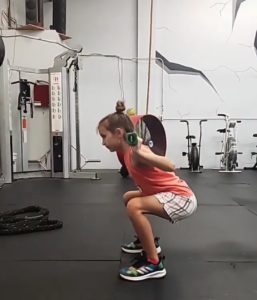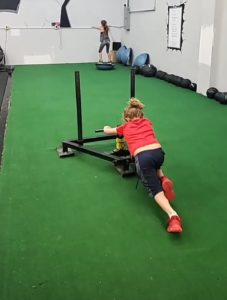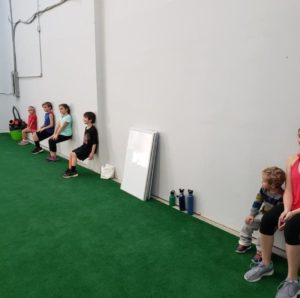Forget Spring, We prefer year long Cleaning!!
Why do we clean?
Cleans are the most powerful barbell movement we will do. It requires you to derive power from the entire body which requires synergistic recruitment of muscles in both the lower and upper body, as well as posterior or anterior chains. The clean can help improve power in the body that can translate to other movements. It’s also a movement that requires bilateral symmetry due to the nature of the movement. If one side of the body works harder than the other, the bar isn’t gonna get up. The clean is a great movement to master because of the benefits you get either in preparation, building mobility as well as body mechanics and awareness or in the subsequent perks of building strength and power that translates to other movements to burning tons of calories while improving neurological function. We all need cleans!
Much different than a squat, the clean won’t look very different from person to person. While they are much more difficult for people with longer levers, each piece of the movement from the pulling to the catch, it should look similar on each person.
Steps
- Foot Placement. Start with feet at hip width. (Why? A foot placement that is too wide can take away power from your jump and pull. Too narrow of a stance makes your pull much longer and requires bigger take off which will cause the bar to float higher.)
- Bar Grip (wrapped vs unwrapped). An unwrapped grip can help your catch with lighter weight. As the bar gets heavier, you’ll need a stronger grip to be able to catch the bar.
- Straight back and core braced – Like in a deadlift, a straight back is important for preventing breakdowns in the movement. (Why? Without a straight back, you lose engagement in both the glutes and core.)
- Shrug. The shrug commences the upper body portion of the lift and helps generate power from the shoulders. (Why? Without the shoulders and pulling portion you won’t be able to commence to a catch. The shrug helps pull that bar up to progress to the swinging forward of the elbows.)
- Straight arms, elbows out and rotate in/forward. The straight arms are gonna help avoid the reverse curl movement. Elbows out helps keep the back straight as well as the arms straight, tightening the triceps to help keep the arms straight. Movement by beginning elbows out will make the upward movement of the bar easier to keep close to the body. Don’t bend at the elbows. The elbows should shoot straight up after the first pull. (Why? Bending the elbows makes the pull much more difficult. It’s easier to catch the bar lower than to pull heavy weight all the way up the body. Because the transition from internal rotation of the shoulder at the beginning of the movement, to an external rotation at the catching portion of the movement, keeping your elbows straight as well as the arms helps maintain an internal rotation of the shoulder throughout the crucial power output phase of the movement.)
- Hips/Jump – As the clean is a triple extension exercise, you’ll simulate a jump because you want extension in the ankles and the hips to properly generate enough power from the lower body. (Why? The hips are a lot like rubber bands, they generate a lot of power. Try to pop those hips and drive them forward to generate as much power as possible.)
- Punch elbows forward. The catch may be one of the most difficult parts of the clean. Elbows must remain high. (Why? Keeping the elbows high helps position the bar properly so that it is resting on your chest and front delt. If you catch the bar with elbows too low, you will catch the bar on your hands and in the wrists which puts unnecessary stress on the wrists. Plus with the elbows being too low, you’ll catch the bar in front of your body instead of stacked on your body which will leave more opportunity for a missed catch. Your body as a whole has more power for stabilization than the wrists and forearms.)
Helpful Hints
Think of swinging your hands and elbows under the bar. The hands will do a full 180 degree rotation around the bar so during the pull to the catch thing about swinging your hands all the way around the bar. This can also help get the elbows up high.
Internal shoulder rotation the beginning and external in the end.
Keep shoulders above the bar
Brace the core
Your hands DO NOT have to be gripping the bar in the rack position like they would be in the pulling phase.
Common Mistakes
On a hang, don’t drop bar to far beneath the knees
(Simple fix, just don’t drop the bar too far. Keep it above the knee)
Shoulders dropping with bar can lead to bar traveling further away from the body
(Tighten back and keep bar close to the body)
Gripping the bar during the catch and rack.
(fix by trying to unwrap your thumbs when catching.)
Setting up with the bar over the toes.
(If you start over the toes, the bar path becomes rounded instead of straight, slide the hips back and start with the bar over midfoot)
Lifting the chest too high
(Keep the back over the bar, lifting the chest too high will lead to a backwards lean. Unlike that you’d do in a deadlift, lifting the chest can take away the power from the lower body and instead engages the lowerback)
Assessments
A simple rack position test, just simply place your thumbs on your collar bones and see what position your elbows rest in. Too wide is most likely lat tightness, too low is from shoulder tightness.
Sit on the floor with an x mark, sit with a straight back and put your hands across your chest and rotate with either a pvcp pipe or straight object and rotate your torso. The bar should cross across the front of the x of which you’re sitting on.
Sit criss-crossed on the floor against the wall. While holding a pipe or light, wide gripped object, see how far you can go back to assess tight lats for the rack position. Grip the bar in both a regular as well as reverse grip.
Improving The Rack Position
The rack position can be the trickiest part of not only a clean, but any front loaded bar movements. The rack position is what we see in the photo above, the position in which you put the bar on your front delts and chest. Due to a lack of shoulder mobility, wrist and forearm tightness or lat tightness, the rack position can be a tricky skill to attain. An important que to try to remember is get those elbows up as high as possible. By the time you catch the bar in the rack position you won’t have a full grip on the bar, the way you did in the pulling part of the movement. Here are a few ways to try and improve that tricky rack position.
Partner forced rack position hold. With the bar on the rack start in the rack position. From there, your partner will push your elbows up to force an exaggerated rack position. This will help you not only gain familiarity with the position, but loosen up those lats to get that position more comfortable.
Next we’ll need to try to gain some flexibility and range of motion through the wrists. To do this, we’ll start on all fours. Straighten the arms and shift the weight of your body forward moving from your shoulders starting stacked directly above the hands to the bottom of the chest being over the hands. We’ll perform this a few times and from there we’ll progress to your hands beginning sideways. From there we will shift the body weight side to side over the hands. After a few reps, we will finally rotate the palms backwards, fingers facing the knees. In this position, we will push our body weight backwards to bring a stretch to the bottom of the forearms.
After we loosen up the wrists we’ll go to another forced rack position. This time you’ll just need a band to wrap around your wrist. From there, face opposite of the band and lift your elbow up in a front rack position and just let the band do its job as it pulls that wrist down as well as bringing that elbow into your rack position.
The last thing is just simple front squatting. The front squat is the best way to practice the rack position as the bar holds you into that position throughout the movement. Simply put, squats fix everything
Mobility and Stretching
Lats
- Rotated rack pull. Have the side of your body face the bar. Reach your opposite hand over top of your body to grab the bar. Pull your body away from the bar with your hand braced against the bar.
- Cat cow. On all fours, round out your upper back and slowly push the chest down out of the rounded back into an arched lower back.
- Down Dog. Start in a pushup position and with a straight back, push your butt straight back, while keeping the arms and legs straight. (To intensify the stretch, drive your chest towards your legs)
- Elbows up stretch. Find a wall or bar and reach your elbow up vertically towards the ceiling and press your tricep against the wall. Press your weight into the arm or step forward past the arm.
Shoulders
- Prone pipe Y raise. In a prone position on the floor with a straight object and arms extended, raise your arms up straight above you. Try to get the object above your head and shoulders.
- Hand on wall stretch. Find a wall and hinge at the hips. Straighten your arms out and brace the wall with your hands. From there sink your chest to the floor while maintaining your hand position.
- Band on bottom of rack each behind your head as if you were going to perform a tricep extension laterally, but allow to band to pull your hand to stretch the shoulder and triceps as well as the lat.
- With a pipe or strap, grab the object from the top behind the head and from the bottom below the waist with the bottom hand.
Hips
- Squat to stand with hands on feet or ankles. Squat down and wrap your hands around your ankles or hold your hands above your feet. From there extend the knees and lift the butt.
- In a deep squat, press your elbows out against your inner thigh.
- 90 degree hip rotation and presses. In a seated position, put both legs at 90 degrees, rotate your torso to face the front leg, press onto your knees through your hips. Rotate your legs so the opposite knee is facing forward and repeat.
Thoracic
- Start kneeling with your elbows on box or bench and curl pipe behind the head
- In childs pose, forearms straight out in front of you on a foam roller and sink chest towards the ground.
- In a seated position with a bar on your back, straight back and rotate.
Closing
Always remember that the clean is a very violent and aggressive movement. If you don’t attack it as such, it will fight back!









